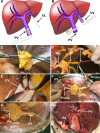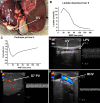Ex Situ Machine Perfusion of Human Donor Livers via the Surgically Reopened Umbilical Vein: A Proof of Concept
- PMID: 30801511
- PMCID: PMC6756251
- DOI: 10.1097/TP.0000000000002615
Ex Situ Machine Perfusion of Human Donor Livers via the Surgically Reopened Umbilical Vein: A Proof of Concept
Abstract
Background: Machine perfusion of donor livers is typically performed via the portal vein main stem. Instead, cannulation of a reopened umbilical vein could allow machine perfusion during organ procurement and subsequent implantation in the recipient without interruption of the portal venous circulation. We aimed to assess the feasibility of portal venous machine perfusion via the umbilical vein.
Methods: During back table inspection of 5 human livers declined for transplantation, the umbilical vein was surgically reopened, dilated, and cannulated. Hypothermic and normothermic oxygenated machine perfusion (NMP) were performed using the umbilical vein for portal inflow. Three livers were perfused with hypothermic machine perfusion, 1 full liver graft underwent NMP for 4 hours, and 1 left lateral split procedure was performed under continuous NMP with portal perfusion via the umbilical vein.
Results: In all livers, access to the portal venous system via the umbilical vein was successfully achieved with good portal flows and macroscopically homogeneous perfusion. The full liver graft that underwent NMP via the umbilical vein for 4 hours showed good lactate clearance, normalized pH, and achieved good bile production with pH >7.55. During the split procedure under continuous NMP via the umbilical vein, the left lateral segment and extended right lobe remained equally perfused, as demonstrated by Doppler ultrasound.
Conclusions: Machine perfusion with portal perfusion via the umbilical vein is feasible. Portal venous flows were similar to those obtained after cannulation of the portal vein main stem. This technique enables continuous oxygenated perfusion of liver grafts during procurement, splitting, and implantation.
Figures



References
-
- Durand F, Renz JF, Alkofer B, et al. Report of the paris consensus meeting on expanded criteria donors in liver transplantation. Liver Transpl 200814121694–1707 - PubMed
-
- de Meijer VE, Fujiyoshi M, Porte RJ. Ex situ machine perfusion strategies in liver transplantation. J Hepatol 2019701203–205 - PubMed
-
- He X, Guo Z, Zhao Q, et al. The first case of ischemia-free organ transplantation in humans: a proof of concept. Am J Transplant 2018183737–744 - PubMed
-
- Soyama A, Eguchi S, Takatsuki M, et al. Tumor thrombectomy via a surgically reopened umbilical vein combined with right hemihepatectomy in a patient with hepatocellular carcinoma. Dig Surg 2011283222–225 - PubMed
MeSH terms
LinkOut - more resources
Full Text Sources
Medical

